科技论文的篇章结构
科技论文的一般格式

科技论文的一般格式第一篇:科技论文的一般格式科技论文的一般格式科技论文的写作有相对固定的格式,虽然不同的刊物在某些方面有特定的要求,但写作论文仍可参照下述要求编撰。
原文《科技论文写作讲义》,作者孙鸣远,有兴趣的同志可在百度搜索网站上查阅。
一、论文结构合理通用结构顺序为:题名、作者署名、摘要、关键词、引言、正文、结论(和建议)、致谢、参考文献和附录。
二、题名要求(一)准确得体。
题名应能准确地表达论文的中心内容,恰如其分地反映研究的范围和达到的深度,不使用笼统的、泛指性很强的词语和华而不实的词藻。
(二)简短精练。
题名应简明,使读者印象鲜明,便于记忆和引用。
题名一般不宜超过20字。
(三)便于检索题名所用词语必须有助于选定关键词和编制题录、索引等二次文献,以便为检索提供特定的实用信息。
(四)容易认读。
题名中应当避免使用非共知共用的缩略词、首字母缩写字、字符、代号等。
三、署名位置与格式通常,学术性期刊中将署名置于题名下方,并采用如下格式:作者姓名(作者工作单位名称及地址)四、摘要应写的内容一般包括研究工作的目的、方法、结果和结论,而重点是结果和结论。
(一)人称。
摘要只能用第三人称而不用其他人称来写。
(二)简短精练,明确具体。
简短,指篇幅短,一般要求50-300字;精练,指摘录出原文的精华,无多余的话;明确具体,指表意明白,不含糊,无空泛、笼统的词语,应有较多而有用的定性和定量的信息。
(三)格式要规范。
尽可能用规范术语,不用非共知共用的符号和术语。
不得简单地重复题名中已有的信息,并切忌罗列段落标题来代替摘要。
不分段。
(四)文字表达上应符合“语言通顺,结构严谨,标点符号准确”的要求。
五、关键词是为了满足文献标引或检索工作的需要而从论文中选取出的词或词组。
每篇论文中应专门列出3-8个关键词,它们应能反映论文的主题内容。
六、引言(也叫问题的提出)引言又叫绪论。
引言中要写的内容大致有如下几项:(一)研究的理由、目的和背景。
科技论文写作第五章科技论文的结构与层次安排

• 二、毕业论文的结构和层次
我校毕业论文写作各部分的要求 本科生毕业论文(设计)撰写规范.doc
• 封面——中文摘要——英文摘要——关 键词——目录——正文——参考文献— —附录——致谢——成绩评定表
• 1.标题
• 要求: • (1)用鲜明、醒目、准确、概括、简洁的词
汇,表达出文章的基本内容和基本观点。
• (1)介绍背景法,包括论文的缘起。
• (2)提出问题法,先提出一个或几个问题, 引起读者注意,然后对这些问题展开论述。
• (3)解释题义法,从论文的基本概念入手。
• (4)概括内容法,对全文先来一个总体概括, 然后再用演绎的方式展开写作。
• (5)阐明价值法,课题的理论价值、历史价 值和实践价值。
• 1、正文层次标题应简短明确,以不超过15字为宜, 题末不加标点符号。理、工、农科论文各层次一律用 阿拉伯字连续编号,如:“1”,“2.1”,“3.1.2”, 一律左顶格,后空一字距写标题。一级标题从前言起 编,一律用黑体4号字,左顶格。文科类论文格式序 号可以用 一、(一)、1、等格式,也可以采用理、 工、农科论文格式。
• 前言长短: • 引言长短视论文长短而定。长度约占正文的
1/10~1/8
• 引言主要内容
➢尽可能清楚地提出所研究问题的性质和范 围
➢对有关重要的文献进行评述; ➢ 阐述研究方法以及选定这种特定方法的理
由
➢ 阐述研究的主要结果以及效益等 ➢实验性的论文还应说明工作场所、协作单
位和工作期限等
• 五种论文开篇的方法:
了定量分析,并结合其特点进行了特性分析;第二,从内容、节
目编排以及传播环境对广州地铁电视传播效果产生的影响等三方
面,归纳出广州地铁电视的现存问题;第三,根据分析得出的结
关于科技论文基本结构和内容简述

关于科技论文基本结构和内容简述关于科技论文的写作,蓝译编译认为,应先了解科技论文基本结构和内容。
一般来说,一篇科技论文应包括题名、摘要、关键词、正文、参考文献及致谢等,其中正文部分包括引言、材料与方法、结果、讨论及结论。
科技论文各部分基本内容如下:题名:是科技论文的必要组成部分,应简明、具体、确切,能概括论文的特定内容,有助于选定关键词,符合编制题录、索引和检索的有关原则。
摘要:是文稿的一个浓缩版本,介绍文章的背景、方法、具体做了哪些工作和得到了什么结果。
它突出强调了所涵盖的要点,简洁地描述了其内容和范围,并以缩略的形式概述其材料。
通常它是首先被阅读的部分,必须简洁易懂、要点突出。
关键词:用于表达文献主题内容,便于文献检索。
引言:目的是激发读者对论文的兴趣,并提供对理解论文其他部分所必需的相关背景信息。
必须概括出将要提出的问题,提供关于主题的背景,讨论有关该主题以前的研究,并准确地揭示论文将给出什么内容,为何要给出这些内容及如何给出。
材料和方法:精确地描述所做的内容,实验如何进行,内容是什么,仪器和材料使用的内容、剂量、频次、地点、时间等。
保证提供足够的细节部分来证明研究发现的真实性,并使该研究能够被重复。
结果:该部分目的是在不需解释其意义的情况下有条理地展示研究的关键结果。
讨论:主要职能是回答引言部分提出的问题,解释实验结果如何支持结论,以及结果是如何与关于该主题的现存知识相吻合的。
结论:在理论分析和实验验证基础上,通过归纳推理得到的富有创造性、指导性、经验性的结果,与引言相呼应,反映论文或研究成果的价值,是对研究结果的深入一步认识。
参考文献:是文章或著作等写作过程中参考过的文献,是科技论文的重要组成部分。
参考文献注明了被引理论、观点、方法、数据的来源,反映了论文的真实科学依据。
不仅能为作者的论点提供有力的论据,而且可以精炼文字节约篇幅,增加论文的信息量,具有很高的信息价值。
引用一定数量的参考文献,既表明学科的继承性和作者对他人劳动成果的尊重,也为编辑部、审稿专家和读者提供了鉴别论文价值水平的重要信息。
科技小作文的结构框架
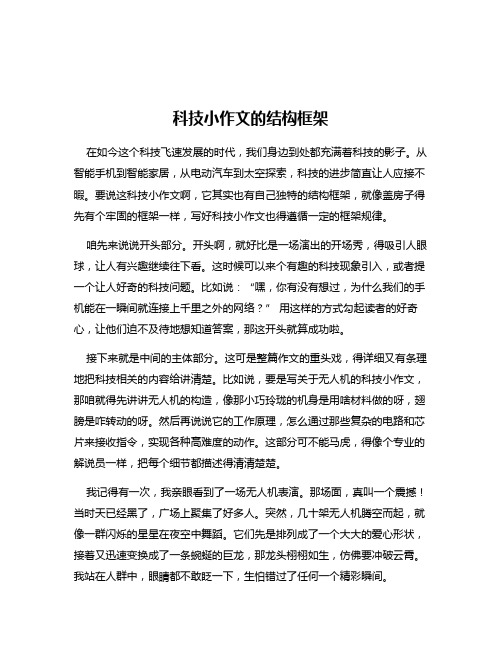
科技小作文的结构框架在如今这个科技飞速发展的时代,我们身边到处都充满着科技的影子。
从智能手机到智能家居,从电动汽车到太空探索,科技的进步简直让人应接不暇。
要说这科技小作文啊,它其实也有自己独特的结构框架,就像盖房子得先有个牢固的框架一样,写好科技小作文也得遵循一定的框架规律。
咱先来说说开头部分。
开头啊,就好比是一场演出的开场秀,得吸引人眼球,让人有兴趣继续往下看。
这时候可以来个有趣的科技现象引入,或者提一个让人好奇的科技问题。
比如说:“嘿,你有没有想过,为什么我们的手机能在一瞬间就连接上千里之外的网络?” 用这样的方式勾起读者的好奇心,让他们迫不及待地想知道答案,那这开头就算成功啦。
接下来就是中间的主体部分。
这可是整篇作文的重头戏,得详细又有条理地把科技相关的内容给讲清楚。
比如说,要是写关于无人机的科技小作文,那咱就得先讲讲无人机的构造,像那小巧玲珑的机身是用啥材料做的呀,翅膀是咋转动的呀。
然后再说说它的工作原理,怎么通过那些复杂的电路和芯片来接收指令,实现各种高难度的动作。
这部分可不能马虎,得像个专业的解说员一样,把每个细节都描述得清清楚楚。
我记得有一次,我亲眼看到了一场无人机表演。
那场面,真叫一个震撼!当时天已经黑了,广场上聚集了好多人。
突然,几十架无人机腾空而起,就像一群闪烁的星星在夜空中舞蹈。
它们先是排列成了一个大大的爱心形状,接着又迅速变换成了一条蜿蜒的巨龙,那龙头栩栩如生,仿佛要冲破云霄。
我站在人群中,眼睛都不敢眨一下,生怕错过了任何一个精彩瞬间。
每架无人机身上都有五颜六色的灯光,随着它们的位置变化,整个图案也不断地变换着。
我在想,这背后得有多么精密的控制和计算啊!那些操控无人机的技术人员,一定是经过了无数次的调试和练习,才能让这些小家伙如此听话,展现出如此精彩绝伦的表演。
我凑近了一些,想看看这些无人机到底有什么特别之处。
只见它们的机身轻巧而坚固,翅膀转动得飞快,发出轻微的嗡嗡声。
我猜那里面一定装着各种高科技的传感器和芯片,才能让它们如此精准地定位和飞行。
科技论文的结构有哪些以及各部分所要注意哪些事项

科技论文的结构有哪些以及各部分所要注意哪些事项?
答:1.题名
1.1题名的要求
题名是一篇论文的总标题,也称篇名或文题,作为一篇论文的总名称,题名应该使读者能从中了解到该论文所要研究的核心内容和主要观点,撰写题名一定要准确、简洁、鲜明,既不能过于空泛和一般化,也不宜过于繁琐,使人得不出鲜明的印象。
2.摘要
摘要应概括说明全文的主要内容,包括目的、方法、结果和结论4个方面,应重点写出具体的研究结果,特别是创新之处。
3.关键词
关键词是从论文的题名、层次标题、摘要、和正文中选出来的,能反映论文主题概念的词和词组。
4.引言
引言作为论文的开端,主要是交待研究成果的来龙去脉,即回答为什么要研究相关的课题,目的是引出作者研究成果的创新论点,使读者对论文要表达的问题有一个总体的了解,引起读者阅读论文的兴趣。
5.正文
正文是引言之后、结论之前的部分,也是论文的核心部分。
作者论点的提出、论据的陈述、论证的过程、结果和讨论都要在此得以展现。
6.结论
科技论文的结论应有主次之分,依其重要性递次排列。
如果结论的内
容较多,可以分条了列出,每一条单成一段。
一段包括几句话,也可能是一句话。
如果结论不多,就不要分条列号。
结论里应包括必要的数据,但主要是用文字表达。
具体要求如下:
(1)概括准确,结构严谨。
(2)明确具体,简短精炼。
(3)客观公正,实事求是。
7参考文献
参考文献著录原则
(1)只著录最必要、最新的文献;
(2)只著录公开发表的文献;
(3)采用标准化的著录格式;
(4)参考文献的数量不宜太少。
科技类论文范文格式
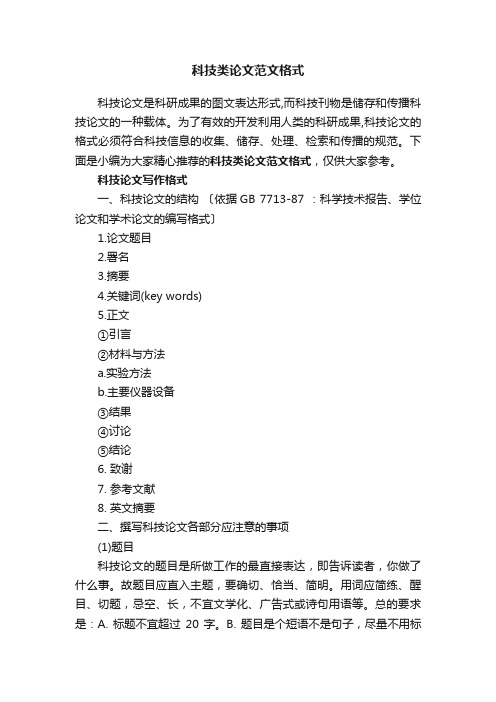
科技类论文范文格式科技论文是科研成果的图文表达形式,而科技刊物是储存和传播科技论文的一种载体。
为了有效的开发利用人类的科研成果,科技论文的格式必须符合科技信息的收集、储存、处理、检索和传播的规范。
下面是小编为大家精心推荐的科技类论文范文格式,仅供大家参考。
科技论文写作格式一、科技论文的结构〔依据GB 7713-87 :科学技术报告、学位论文和学术论文的编写格式〕1.论文题目2.署名3.摘要4.关键词(key words)5.正文①引言②材料与方法a.实验方法b.主要仪器设备③结果④讨论⑤结论6. 致谢7. 参考文献8. 英文摘要二、撰写科技论文各部分应注意的事项(1)题目科技论文的题目是所做工作的最直接表达,即告诉读者,你做了什么事。
故题目应直入主题,要确切、恰当、简明。
用词应简练、醒目、切题,忌空、长,不宜文学化、广告式或诗句用语等。
总的要求是:A. 标题不宜超过20字。
B. 题目是个短语不是句子,尽量不用标点符号。
(2)作者论文都应注明作者,要给出作者姓名,两位作者以上的需排序,以承担工作任务大小和实际贡献来决定先后次序。
(3)关键词(key words)关键词是适应计算机管理而产生的,是论文题目中最关键的3-5个词。
如“石林地区蝴蝶种类调查及区系组成研究”,其关键词为:石林蝴蝶种类区系调查,“交通噪声对人的危害实验及防治方法的探讨”关键词为:交通噪声危害防治。
(4)摘要摘要是这篇论文的浓缩,也可以说是论文的简要介绍。
摘要应包括实验的主旨、缘由、目的、范围、时期、主要内容、取得的结果、结论及其价值及意义。
摘要是一篇完整的短文,能够独立使用(可以编为论文摘要集,一般在600-1500字),它能使读者完整地了解原论文的概貌。
因此摘要必须是完整、准确、简练地代表原文(但不能代替原论文),要求言简意切。
摘要的注意事项:① 使用第三人称。
② 不加注释和评论、不举例子、不用引文。
③ 不用图表、公式等。
④ 第一句话尽量少用“本文……”、“作者……”。
如何撰写SCI科研论文的论文结构与章节分配
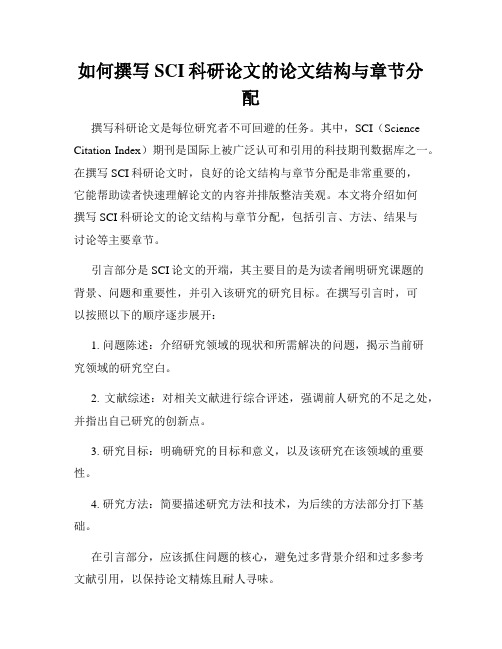
如何撰写SCI科研论文的论文结构与章节分配撰写科研论文是每位研究者不可回避的任务。
其中,SCI(Science Citation Index)期刊是国际上被广泛认可和引用的科技期刊数据库之一。
在撰写SCI科研论文时,良好的论文结构与章节分配是非常重要的,它能帮助读者快速理解论文的内容并排版整洁美观。
本文将介绍如何撰写SCI科研论文的论文结构与章节分配,包括引言、方法、结果与讨论等主要章节。
引言部分是SCI论文的开端,其主要目的是为读者阐明研究课题的背景、问题和重要性,并引入该研究的研究目标。
在撰写引言时,可以按照以下的顺序逐步展开:1. 问题陈述:介绍研究领域的现状和所需解决的问题,揭示当前研究领域的研究空白。
2. 文献综述:对相关文献进行综合评述,强调前人研究的不足之处,并指出自己研究的创新点。
3. 研究目标:明确研究的目标和意义,以及该研究在该领域的重要性。
4. 研究方法:简要描述研究方法和技术,为后续的方法部分打下基础。
在引言部分,应该抓住问题的核心,避免过多背景介绍和过多参考文献引用,以保持论文精炼且耐人寻味。
方法部分是SCI论文的核心,它详细介绍了作者所采取的研究方法和技术,以及实验的设计与实施。
在写作方法部分时,建议按照以下顺序进行叙述:1. 研究设计:详细描述实验设计、样本选择、实验流程等。
2. 数据收集:介绍数据收集的方法、工具、步骤以及所获得的主要数据。
3. 数据分析:说明数据分析的方法和软件工具,以及分析结果的解读。
4. 实验验证与控制:讨论如何验证实验结果的可靠性,并阐述对可能的影响因素的控制。
方法部分应该精确详实,以确保其他研究者能够重复实验并获得相似的结果。
结果与讨论部分是SCI论文的重要组成部分,它主要呈现研究实验的结果,并进行合理解读和分析。
在写作结果与讨论时,可以采用以下结构:1. 结果呈现:用图表、表格等形式展示实验数据,使得读者可以直观地了解实验结果。
2. 结果讨论:对结果进行解读和分析,与前期的研究进行比较,并讨论出现的异常或突出的问题。
一般的科技论文格式

一般的科技论文格式科技论文目前虽然还没有统一规定的国际格式 , 但已渐趋统一。
我国国家标准局于 1982 年发布的《科技学术期刊编排规则》(gb3179 一82,1982 一 09一01发布,1983 一 07一 01试行)。
这将体现我国的科技期刊也渐趋统一。
目前各类科技期刊已基本按照该《规则》编排 , 这将是符合客观实际和人们的认识过程的规律, 它具有简明的特点 ,在长期的实践中定会乐于受人们习用。
但具体到每篇 *, 还要根据内容的实际需要以及各类期刊的要求 , 作适当取舍 , 下面就我院学报论文的格式 , 作一些说明和应注意的问题 , 希能给作者有所帮助。
一、论文的基本结构1、文题文题统称为论文的标题。
一篇论文出现在读者面前的首先是论文的标题 ,标题是该论文的眉目 ,是给读者的第一印象 , 必须反复思考,主要把握住:①清晰、简明、扼要、准确地表达*的主题; ②切冗长繁杂、一般不超过 20个字; ③便于检索、分类及摘录卡片。
*的标题要尽可简短 ,对于某些 *标题实在过长的可用副标题来限制。
2、作者作者必须是参加了该研究工作的全部或主要工作 , 并参加撰写论文的人。
对于给予该研究工作或写作时支援和帮助的人 , 不应列入作者栏 ,可在志谢中说明。
校友的论文还必须注明所在的工作单位。
切忌把照顾关系 , 亲朋好友的人列入作者栏。
本学报论文作者一般不超过三名。
3、提要提要是全文的简明重点 , 使读者能迅速掌握全文的梗概。
提要应当写成单独的一段具有独立性的短文 , 主要介绍所研究的目的、方法、结果 , 文字限于 200~300字。
4、关键词关键词又称主题词 , 是供贮存和检索之用。
关键词是指与 * 主题最有关系的一些词或词组 , 它有时出现在文题中 , 但大多数出现在提要和正文中。
选用关键词可按《汉语主题词表》作为依据。
一篇论文可选取 3~8 个词或词组作为关键词 , 多了反而会影响*的主题和检索效果。
5、外文标题作者提要关键词外文提要同中文提要的内容一样 , 就是翻译中文提要。
科技论文中引言的结构与功能
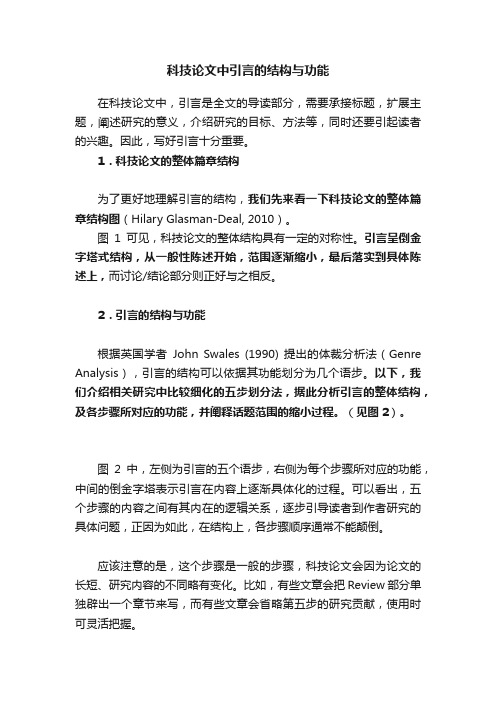
科技论文中引言的结构与功能在科技论文中,引言是全文的导读部分,需要承接标题,扩展主题,阐述研究的意义,介绍研究的目标、方法等,同时还要引起读者的兴趣。
因此,写好引言十分重要。
1.科技论文的整体篇章结构为了更好地理解引言的结构,我们先来看一下科技论文的整体篇章结构图(Hilary Glasman-Deal, 2010)。
图1可见,科技论文的整体结构具有一定的对称性。
引言呈倒金字塔式结构,从一般性陈述开始,范围逐渐缩小,最后落实到具体陈述上,而讨论/结论部分则正好与之相反。
2.引言的结构与功能根据英国学者John Swales (1990) 提出的体裁分析法(Genre Analysis),引言的结构可以依据其功能划分为几个语步。
以下,我们介绍相关研究中比较细化的五步划分法,据此分析引言的整体结构,及各步骤所对应的功能,并阐释话题范围的缩小过程。
(见图2)。
图2中,左侧为引言的五个语步,右侧为每个步骤所对应的功能,中间的倒金字塔表示引言在内容上逐渐具体化的过程。
可以看出,五个步骤的内容之间有其内在的逻辑关系,逐步引导读者到作者研究的具体问题,正因为如此,在结构上,各步骤顺序通常不能颠倒。
应该注意的是,这个步骤是一般的步骤,科技论文会因为论文的长短、研究内容的不同略有变化。
比如,有些文章会把Review部分单独辟出一个章节来写,而有些文章会省略第五步的研究贡献,使用时可灵活把握。
3.实例分析以下是一篇材料学相关论文的引言部分,我们来分析下该引论的结构及功能。
The synthesis of flexible polymer blends from polylactide and rubberIntroduction1 Polylactide (PLA) has received much attention in recent years due to its biodegradable properties, which offer important economic benefits.2 PLA is a polymer obtained from corn and is produced by the polymerization of lactide.3 It has many possible uses in the biomedical field1 and has also been investigated as a potential engineering material.4 However, it has been found to be too weak under impact to be used commercially.5 One way to toughen polymers is to incorporate a layer of rubber particles and there has been extensive research regarding the rubber modification of PLA.6 For example, Penney et al. showed that PLA composites could be prepared using blending techniques and more recently, Hillier established the toughness of such composites.7 However, although the effect of the rubber particles on the mechanical properties of copolymer systems was demonstrated over two years ago, little attention has been paid to the selection of an appropriate rubber component.8 The present paper presents a set of criteria for selecting such a component. 9 On the basis of these criteria it then describes the preparation of a set of polymer blends using PLA and a hydro-carbon rubber (PI). 10 This combination of two mechanistically distinct polymerizations formed a novel copolymer in which the incorporation of PI significantly increased flexibility.文章第1段提供了论题的setting(Stage 1),包括其重要性,必要的背景知识和存在的问题(见旁注)。
科技文章的常见结构
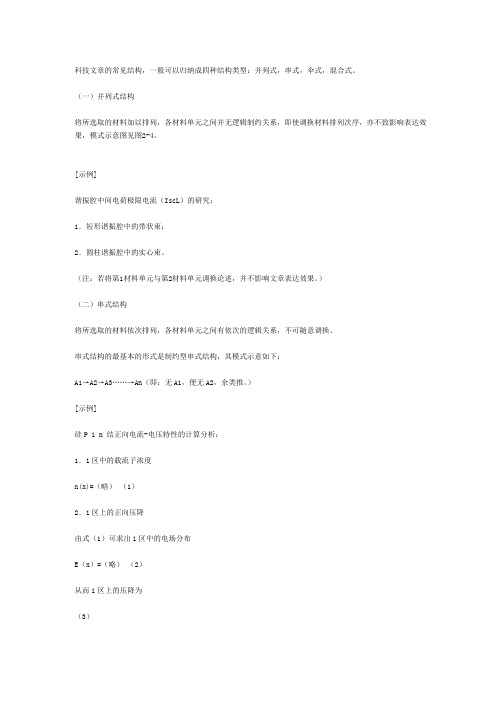
科技文章的常见结构,一般可以归纳成四种结构类型:并列式,串式,伞式,混合式。
(一)并列式结构将所选取的材料加以排列,各材料单元之间并无逻辑制约关系,即使调换材料排列次序,亦不致影响表达效果,模式示意图见图2-4。
[示例]谐振腔中间电荷极限电流(IscL)的研究:1.短形谐振腔中的带状束;2.圆柱谐振腔中的实心束。
(注:若将第1材料单元与第2材料单元调换论述,并不影响文章表达效果。
)(二)串式结构将所选取的材料依次排列,各材料单元之间有依次的逻辑关系,不可随意调换。
串式结构的最基本的形式是制约型串式结构,其模式示意如下:A1→A2→A3……→An(即:无A1,便无A2,余类推。
)[示例]硅P i n 结正向电流-电压特性的计算分析:1.i区中的载流子浓度n(x)=(略)(1)2.i区上的正向压降由式(1)可求出i区中的电场分布E(x)=(略)(2)从而i区上的压降为(3)其中,没有第1节的结论[式(1)],即无后面的延续推导及结果[式(3)]除制约型串式结构模式以外,还有递增(或递减)型串式结构与时间顺序型串式结构。
前者可通过材料单元的有序排列给人以循序渐进的节奏感;后者则可通过对时间、空间的顺序表达,给人以清晰的层次感。
(三)伞式结构这种结构是指某一层次的论点由两个或两个以上的论据支撑着的结构,即只有同一层次的两个或两个以上材料单元同时成立时,上一层次的材料单元才能成立,其模式示意图见图2-5。
[示例]证明明任意三角形三内角之和为180度。
以上所示属于单层伞式结构,除此以外,还有多层伞式结构,其示意图见图2-6。
(a1)锐角三角形三内角之和为180o(a2)钝角三角形三内角之和为180o 任意三角形三内角之和为180o(a3)直角三角形三内角之和为180oA(四)复式结构实际上,我们在撰写论文时,并不一定要拘泥于伞式结构一种模式。
应根据论文内容的内在逻辑联系,构思有关阐析、推理及反驳等论证的实质部分如何穿插安排、展开,才能全面、准确、简明地说明问题,可以灵活运用“复合型结构”。
科技论文写作格式与方法

作者姓名的拼音表达方式
国家标准(GB/T 16159-1996) : 汉语人名按姓和名
分写, 姓和名的开头字母大写, 如: Wang Jianguo (王 建国), Dongfang Shuo (东方朔), Zhuge Kongming (诸 葛孔明), 等;
“中国学术期刊 ( 光盘版 ) 检索与评价数据规 范” :姓前名后, 姓氏的全部字母均大写, 复姓应连
(4) 处置(Interventions): 处置方法;
(5) 主要结果测定(Main Outcome Measures): 实验过程;
(6) 结果和结论(Results & Conclusions): 研究的主要发 现、主要结论等
Keywords (关键词)
从论文提炼出来,最能反映论文主要内容, 可为编制主题索引和检索系统使用; 不要使用过于宽泛的词做关键词(例如:有机 化合物,生态科学,等等),以免失去检索的 作用; 避免使用自定的缩略语作为关键词,除非是 科学界公认的专有缩写字(如: DNA); 关键词的数量要适中,一般为 3 ~ 5 个,最好 不要超过 8 个
Who are the authors?
国际医学期刊编辑委员会(ICMJE)有关作者资 格的界定:
(1) 课题的构思与设计,资料的分析和解释;
(2) 文稿的写作或对其中重要学术内容作重大修改;
(3) 参与最后定稿,并同意投稿和出版
— 以上3项条件应全部具备方可成为作者; 作者的 排列顺序应由所有作者共同决定; 每位作者都应该 能够就论文的全部内容向公众负责
学术论文:学术性论文、技术性论文、 综述性论文
学位论文:学士、硕士、博士论文
科研论文的结构与写作要点
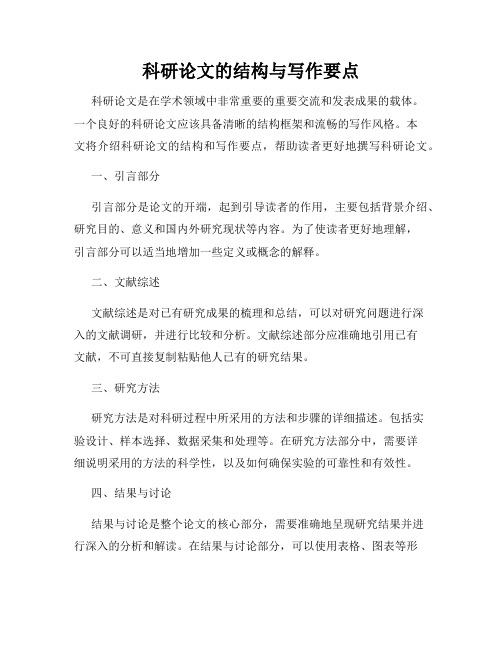
科研论文的结构与写作要点科研论文是在学术领域中非常重要的重要交流和发表成果的载体。
一个良好的科研论文应该具备清晰的结构框架和流畅的写作风格。
本文将介绍科研论文的结构和写作要点,帮助读者更好地撰写科研论文。
一、引言部分引言部分是论文的开端,起到引导读者的作用,主要包括背景介绍、研究目的、意义和国内外研究现状等内容。
为了使读者更好地理解,引言部分可以适当地增加一些定义或概念的解释。
二、文献综述文献综述是对已有研究成果的梳理和总结,可以对研究问题进行深入的文献调研,并进行比较和分析。
文献综述部分应准确地引用已有文献,不可直接复制粘贴他人已有的研究结果。
三、研究方法研究方法是对科研过程中所采用的方法和步骤的详细描述。
包括实验设计、样本选择、数据采集和处理等。
在研究方法部分中,需要详细说明采用的方法的科学性,以及如何确保实验的可靠性和有效性。
四、结果与讨论结果与讨论是整个论文的核心部分,需要准确地呈现研究结果并进行深入的分析和解读。
在结果与讨论部分,可以使用表格、图表等形式来呈现数据,以便读者更好地理解。
并且,需要对结果进行客观的评价和讨论,指出可信度,分析结果的原因,并与已有文献进行比较。
五、结论结论部分是对整篇论文的总结和归纳,需要明确地回答研究目的。
结论要简洁明了,回答问题的同时可以提出进一步研究的方向和建议。
六、参考文献参考文献是对所引用文献的详细罗列和标注。
参考文献应按照学术规范进行引用,并且需要确保所引用的文献来源可信、权威。
七、致谢(可选)致谢部分用于感谢对研究工作有重要帮助的人或机构。
在致谢时需要表达真挚的感激之情。
在写作科研论文时,还有一些值得注意的要点:1. 语言要准确、简练。
避免使用过于复杂的词汇和句式,以免增加读者阅读的难度。
2. 逻辑清晰。
论文应按照合理的顺序进行组织,每个部分之间要有明确的逻辑连接。
3. 数据可靠。
在呈现研究结果时,要确保数据来源的可靠性,在必要时使用合适的统计方法进行数据分析。
科技论文的结构、内容与写作

科研设计的主要内容
8.现有研究条件 研究条件主要指人员条件和物质条件两个 方面。 研究条件是保证完成课题的重要基础
科研设计的主要内容
9.计划进度指标 ①完成整个研究课题所需要的时间 ②几项主要工作的具体进度计划(各研究 阶段所要达到的目标和时间)。
科研设计的主要内容
科研设计的主要内容
1.立题 亦称命题,即为一研究课题拟定一最适当之题目, 做为该项研究的课题名称。这个题目是科研设计 的总纲或其指导中心,也可以说设计中的全部内 容皆由此而发,假说、实验、措施等皆为此而设, 因此它必须是整个科设想与过程的高度浓缩物。 一个好的课题名称,能使人对该项研究工作一目 了然、不仅可知其目的、内容和主要方法,甚至 透过题目还能看出其假说的科学性。欲达此目的, 立题必须力争做到鲜明、具体、确切,若能同时 反映出“立意新颖”则属更佳。
科研设计的主要内容
3.立题依据 此项内容要求回答“为什么要研究这个课题”,应该着重 说明选定此一课题的出发点以及主观与客观的条件是什么, 选题的独创性、完成的可能性及其实际意义(实用性)如 何。有些科研设计在填写本项时,不是内容过多而是文字 太少,叙述往往过于简单或较为抽象。应该认识到,三言 两语、轻描淡写、一带而过的办法,对于争取课题的批准 是不利的,选题依据若不充分,课题的成立就很困难。在 陈述客观对解决这一问题的需要情况时,应该实事求是, 而不要用主观臆断来代替客观事实。几乎任何人都不会说 自己研究的课题客观上不需要,但也不要动辄就把“迫切 需要”或“急待解决”之类的词汇拿来作为“依据”。人 们常常会对这些空洞的说法提出疑问,其可信程度究竟有 多大?因此,最好的办法就是具体而不抽象,摆出事实, 言之有据,令人信服。
初中科学小论文怎么

初中科学小论文怎么写科学小论文是初中科学学习中的一种常见形式,通过研究课题、收集相关资料、进行实验和观察等方式,展示学生科学认知和实践能力。
下面将介绍科学小论文的基本结构和写作步骤,并提供一些写作技巧和注意事项。
一、科学小论文的基本结构1. 引言部分:介绍研究的背景和目的,引起读者的兴趣。
可以提出问题、概述研究领域的重要性,阐明研究目标等。
2. 研究方法:详细说明研究的方法和步骤,包括实验设计、观察方法、数据收集和处理方法等。
3. 结果与分析:展示实验结果或观察到的现象,并对结果进行分析和解释。
可以使用表格、图表等形式来清晰地呈现数据。
4. 讨论和结论:对结果进行讨论,解释结果的意义,并总结研究的结论。
可以与已有理论或实验结果进行对比和分析。
5. 参考文献:列出引用的相关文献,确保学术准确性。
可以使用标准的文献引用格式,如APA格式。
二、科学小论文的写作步骤1. 选择研究课题:选择一个感兴趣且有一定研究价值的科学课题,可以咨询老师或自行探索。
2. 背景资料收集:了解该领域的相关信息,获取背景知识和理论基础。
可以通过阅读科学书籍、期刊、网站等收集资料。
3. 实验设计和数据收集:根据课题确定实验设计和观察方法,并进行实验或观察。
记录数据并进行整理和分析。
4. 撰写论文:按照引言、研究方法、结果与分析、讨论和结论的顺序撰写论文。
注意语句通顺,段落结构清晰。
5. 修订和编辑:对论文进行细致的修改和编辑,确保语法准确、排版整洁美观。
三、科学小论文的写作技巧和注意事项1. 简明扼要:论文中应保持简明扼要的风格,清晰表达自己的理论观点和实践结果。
避免使用复杂的词汇和长句,以免影响表达的准确性。
2. 数据呈现:使用图表、表格等方式呈现数据,有助于读者直观理解和比较。
确保图表标签清晰、标题准确。
3. 引用文献:在论文中引用相关文献时,需注明作者和出处。
可以采用脚注、尾注或直接在正文中引用文献。
4. 逻辑严密:整篇论文应保持逻辑严密,思路清晰。
科技论文的结构有哪些以及各部分所要注意哪些事项

科技论文的结构有哪些以及各部分所要注意哪些事项科技论文的结构有哪些以及各部分所要注意哪些事项?答:1.题名1.1题名的要求题名是一篇论文的总标题,也称篇名或文题,作为一篇论文的总名称,题名应该使读者能从中了解到该论文所要研究的核心内容和主要观点,撰写题名一定要准确、简洁、鲜明,既不能过于空泛和一般化,也不宜过于繁琐,使人得不出鲜明的印象。
2.摘要摘要应概括说明全文的主要内容,包括目的、方法、结果和结论4个方面,应重点写出具体的研究结果,特别是创新之处。
3.关键词关键词是从论文的题名、层次标题、摘要、和正文中选出来的,能反映论文主题概念的词和词组。
4.引言引言作为论文的开端,主要是交待研究成果的来龙去脉,即回答为什么要研究相关的课题,目的是引出作者研究成果的创新论点,使读者对论文要表达的问题有一个总体的了解,引起读者阅读论文的兴趣。
5.正文正文是引言之后、结论之前的部分,也是论文的核心部分。
作者论点的提出、论据的陈述、论证的过程、结果和讨论都要在此得以展现。
6.结论科技论文的结论应有主次之分,依其重要性递次排列。
如果结论的内容较多,可以分条了列出,每一条单成一段。
一段包括几句话,也可能是一句话。
如果结论不多,就不要分条列号。
结论里应包括必要的数据,但主要是用文字表达。
具体要求如下:(1)概括准确,结构严谨。
(2)明确具体,简短精炼。
(3)客观公正,实事求是。
7参考文献参考文献著录原则(1)只著录最必要、最新的文献;(2)只著录公开发表的文献;(3)采用标准化的著录格式;(4)参考文献的数量不宜太少。
以科学为主题的文章结构

以科学为主题的文章结构
科学作为一种系统化的知识体系,一直是人类追求真理和探索未知的
重要方向。
在撰写以科学为主题的文章时,一般需要按照以下结构展开:
1.开篇引入:简单介绍科学的定义和重要性,引出本文的主题。
2.历史沿革:围绕主题,介绍该领域或该问题的历史发展和重要事件。
3.当前探索:介绍该领域或该问题当前的研究方向和成果,引用一些
著名的科学家或研究机构的论文或研究报告。
4.重点分析:对该领域或该问题的研究进展进行深入分析,提出自己
的看法和思考。
5.应用与启示:探讨该领域或该问题对于现实生活的影响和启示,可
能的应用前景和发展趋势。
6.结尾总结:简洁概括文章的主旨和观点,强调科学的重要性并展望
未来的发展方向。
需要注意的是,在撰写科学文章时,需要注重数据和事实的准确性和
全面性,同时也要避免过度华丽的修辞和空洞的评论。
尽量保持客观、理性、简洁,以便更好地传递科学知识和思想。
科技论文主要结构及框架

科技论文主要结构及框架科技论文主要结构及框架科技论文是在科学研究、科学实验的基础上,对自然科学和专业技术领域里的某些现象或问题进行专题研究,运用概念、判断、推理、证明或是反驳等逻辑思维手段,分析和阐述,揭示出这些现象和问题的本质及其规律性而撰写成的文章。
科技论文的主要内容一篇完整的科技论文应包括标题、摘要、关键词、论文的内容、参考文献。
(一)题目题目是科技论文的必要组成部分。
它要求用简洁、恰当的词组反映文章的特定内容,论文的主题明白无误地告诉读者,并且使之具有画龙点睛,启迪读者兴趣的功能。
一般情况下,题目中应包括文章的主要关键词。
题目像一条标签,切忌用较长的主、谓、宾语结构的完整语句逐点描述论文的内容,以保证达到“简洁”的要求;而“恰当”的要求应反映在用词的中肯、醒目、好读好记上。
当然,也要避免过分笼统或哗众取宠的所谓简洁,缺乏可检索性,以至于名实不符或无法反映出每篇文章应有的特色。
题名应简短,不应很长,一般<20个汉字。
(二)著名著名是指在论文主题内容的构思、具体研究工作的执行及撰稿执笔等方面的全部或局部上作出的主要贡献的人员,能够对论文的主要内容负责答辩的人员,是论文的法定权人和责任者。
署名人数不应太多,对论文涉及的部分内容做过咨询、给过某种帮助或参与常规劳务的人员不宜按著者身份署名,但可以注明他们参与了哪一部分具体工作,或通过文末致谢的方式对他们的贡献和劳动表示谢意。
和写论文的著者应按论文工作贡献的多少顺序排列。
著者的姓名应给全名,一般用真实姓名。
同时还应给出著者完成研究工作时的单位或著者所在的工作单位或通讯地址。
(三)文摘文摘是现代科技论文的必要附加部分,只有极短的文章才能省略。
文摘是以提供文献内容梗概为目的,不加评论和补充解释,简明确切地记述文献重要内容的短文,应包括目的、方法、结果、结论。
文摘有两种写法:报道性文摘——指明一次文献的主题范围及内容梗概的简明文摘(也称简介);指示性文摘——指示一次文献的陈述主题及取得的成果性质和水平的简明文摘。
科技论文的篇章结构
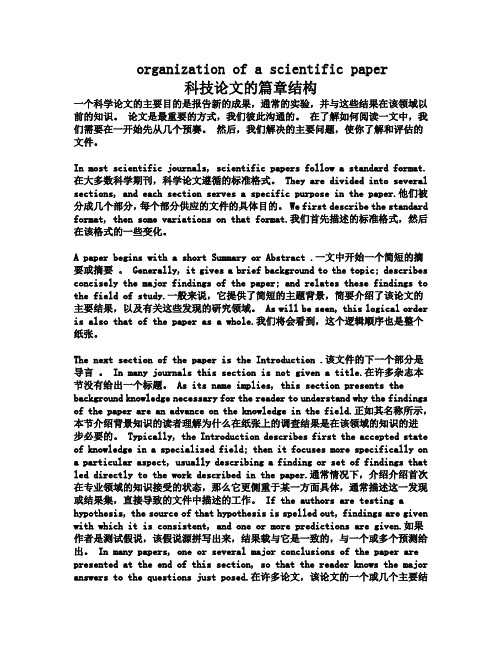
organization of a scientific paper科技论文的篇章结构一个科学论文的主要目的是报告新的成果,通常的实验,并与这些结果在该领域以前的知识。
论文是最重要的方式,我们彼此沟通的。
在了解如何阅读一文中,我们需要在一开始先从几个预赛。
然后,我们解决的主要问题,使你了解和评估的文件。
In most scientific journals, scientific papers follow a standard format.在大多数科学期刊,科学论文遵循的标准格式。
They are divided into several sections, and each section serves a specific purpose in the paper.他们被分成几个部分,每个部分供应的文件的具体目的。
We first describe the standard format, then some variations on that format.我们首先描述的标准格式,然后在该格式的一些变化。
A paper begins with a short Summary or Abstract .一文中开始一个简短的摘要或摘要。
Generally, it gives a brief background to the topic; describes concisely the major findings of the paper; and relates these findings to the field of study.一般来说,它提供了简短的主题背景,简要介绍了该论文的主要结果,以及有关这些发现的研究领域。
As will be seen, this logical order is also that of the paper as a whole.我们将会看到,这个逻辑顺序也是整个纸张。
探究科技论文的结构特点与学术写作

探究科技论文的结构特点与学术写作科技论文是科学研究成果的重要呈现形式,它以严谨的逻辑和准确的数据为基础,通过特定的结构和学术写作规范来表达研究问题、方法、结果和讨论。
本文将探究科技论文的结构特点与学术写作,以帮助读者更好地理解和撰写科技论文。
一、引言部分引言部分是科技论文的开篇,主要用于引出研究问题和研究背景,明确研究目的和意义,并对相关研究进行综述。
通常包括以下几个方面内容:1. 研究背景:介绍研究领域的现状、问题和研究意义,引发读者对研究问题的关注。
2. 文献综述:对前人相关研究进行概述,指出前人研究的不足或存在的问题,并引出本文的研究目的。
3. 研究目的与意义:明确本文的研究目的、研究问题和研究意义,为后续内容的展开做好铺垫。
二、方法部分方法部分是科技论文的核心,描述了研究的方法和实验设计。
在这一部分中,需要准确而详细地描述实验的设计、数据采集和处理方法等内容。
具体包括以下几个方面:1. 研究设计:介绍实验的整体设计和研究方法,包括实验对象、实验组和对照组的设置,以及实验的时间和空间范围等。
2. 数据采集:描述数据的来源和采集方法,包括实验设备的使用、实验操作过程的描述等。
3. 数据处理:介绍数据的处理方法和统计分析方法,包括采用的软件和算法等。
三、结果部分结果部分是科技论文的核心内容之一,用于呈现研究的实验结果。
在这一部分中,需要准确地呈现实验数据,并进行合理的分析和解释。
具体包括以下几个方面:1. 数据呈现:通过表格、图表等形式将实验数据准确地展示出来,确保数据的可读性和易于理解。
2. 数据分析:对实验数据进行统计分析和解释,明确实验结果的意义和趋势。
3. 结果讨论:对实验结果进行深入分析和讨论,与前人研究进行比较,指出实验结果的优缺点,并解释其原因。
四、讨论部分讨论部分是科技论文的核心内容之一,用于对实验结果进行解释和分析,并提出对未来研究的展望。
具体包括以下几个方面:1. 结果解释:对实验结果进行全面而深入的解释,明确结果的意义和贡献。
- 1、下载文档前请自行甄别文档内容的完整性,平台不提供额外的编辑、内容补充、找答案等附加服务。
- 2、"仅部分预览"的文档,不可在线预览部分如存在完整性等问题,可反馈申请退款(可完整预览的文档不适用该条件!)。
- 3、如文档侵犯您的权益,请联系客服反馈,我们会尽快为您处理(人工客服工作时间:9:00-18:30)。
organization of a scientific paper科技论文的篇章结构一个科学论文的主要目的是报告新的成果,通常的实验,并与这些结果在该领域以前的知识。
论文是最重要的方式,我们彼此沟通的。
在了解如何阅读一文中,我们需要在一开始先从几个预赛。
然后,我们解决的主要问题,使你了解和评估的文件。
In most scientific journals, scientific papers follow a standard format.在大多数科学期刊,科学论文遵循的标准格式。
They are divided into several sections, and each section serves a specific purpose in the paper.他们被分成几个部分,每个部分供应的文件的具体目的。
We first describe the standard format, then some variations on that format.我们首先描述的标准格式,然后在该格式的一些变化。
A paper begins with a short Summary or Abstract .一文中开始一个简短的摘要或摘要。
Generally, it gives a brief background to the topic; describes concisely the major findings of the paper; and relates these findings to the field of study.一般来说,它提供了简短的主题背景,简要介绍了该论文的主要结果,以及有关这些发现的研究领域。
As will be seen, this logical order is also that of the paper as a whole.我们将会看到,这个逻辑顺序也是整个纸张。
The next section of the paper is the Introduction .该文件的下一个部分是导言。
In many journals this section is not given a title.在许多杂志本节没有给出一个标题。
As its name implies, this section presents the background knowledge necessary for the reader to understand why the findings of the paper are an advance on the knowledge in the field.正如其名称所示,本节介绍背景知识的读者理解为什么在纸张上的调查结果是在该领域的知识的进步必要的。
Typically, the Introduction describes first the accepted state of knowledge in a specialized field; then it focuses more specifically on a particular aspect, usually describing a finding or set of findings that led directly to the work described in the paper.通常情况下,介绍介绍首次在专业领域的知识接受的状态,那么它更侧重于某一方面具体,通常描述这一发现或结果集,直接导致的文件中描述的工作。
If the authors are testing a hypothesis, the source of that hypothesis is spelled out, findings are given with which it is consistent, and one or more predictions are given.如果作者是测试假说,该假说源拼写出来,结果载与它是一致的,与一个或多个预测给出。
In many papers, one or several major conclusions of the paper are presented at the end of this section, so that the reader knows the major answers to the questions just posed.在许多论文,该论文的一个或几个主要结论载于本节结束,让读者知道刚才提出的问题的主要答案。
Papers more descriptive or comparative in nature may begin with an introduction to an area which interests the authors, or the need for a broader database.论文更具描述性的或比较可能开始对一个地区的利益,作者,或为一个更广泛的数据库需要引进。
The next section of most papers is the Materials and Methods .大多数文件下部分是材料和方法。
In some journals this section is the last one.在一些刊物本节是最后一个。
Its purpose is to describe the materials used in the experiments and the methods by which the experiments were carried out.其目的是描述在实验中使用的材料和所依据的实验方法进行。
In principle, this description should be detailed enough to allow other researchers to replicate the work.原则上,这说明应详细到足以让其他研究人员复制的工作。
In practice, these descriptions are often highly compressed, and they often refer back to previous papers by the authors.在实践中,这些描述往往是高度压缩,而且往往是指由作者回以前的文件。
The third section is usually Results .第三部分是平时成绩。
This section describes the experiments and the reasons they were done.本节介绍了实验和他们做的原因。
Generally, the logic of the Results section follows directly from that of the Introduction.一般来说,结果部分逻辑是直接从介绍的。
That is, the Introduction poses the questions addressed in the early part of Results.也就是说,介绍构成在结果初期要解决的问题。
Beyond this point, the organization of Results differs from one paper to another.除了这一点,结果组织不同于一纸到另一个。
In some papers, the results are presented without extensive discussion, which is reserved for the following section.在一些文件,结果没有提出广泛讨论,这是下面的部分保留。
This is appropriate when the data in the early parts do not need to be interpreted extensively to understand why the later experiments were done.这是适当的时候在早期部分的数据不需要进行解释广泛理解为什么后来的实验工作。
In other papers, results are given, and then they are interpreted, perhaps taken together with other findings not in the paper, so as to give the logical basis for later experiments.在其他文件,结果都给出了,然后他们解释,也许没有采取其他研究结果的文件一起,这样才能为以后的实验提供了逻辑基础。
The fourth section is the Discussion .第四部分是讨论。
This section serves several purposes.本节可以有以下几个目的。
First, the data in the paper are interpreted; that is, they are analyzed to show what the authors believe the data show.首先,在文件中的数据进行解释,也就是说,它们进行分析,以显示什么作者认为,数据显示。
Any limitations to the interpretations should be acknowledged, and fact should clearly be separated from speculation.任何的解释限制应该承认,与事实显然应该从炒作分开。
Second, the findings of the paper are related to other findings in the field.二,论文的研究结果与在该领域的其他研究结果。
This serves to show how the findings contribute to knowledge, or correct the errors of previous work.由此足以说明如何促进知识的结果,或纠正以前的工作中的错误。
As stated, some of these logical arguments are often found in the Results when it is necessary to clarify why later experiments were carried out.如前所述,这些逻辑经常发现一些论点在结果的时候,有必要澄清为什么后来进行了实验。
